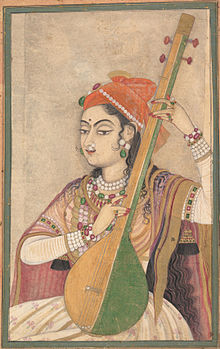Assamese music
| Music of India | |
|---|---|

A Lady Playing the Tanpura, ca. 1735 (Rajasthan)
|
|
| Genres | |
|
|
| Media and performance | |
| Music awards | |
| Music festivals | |
| Music media | |
| Nationalistic and patriotic songs | |
| National anthem | Jana Gana Mana |
| Regional music | |
|
|
The music of Assam (Assamese: অসমৰ সংগীত), a state in the northeastern part of India, can be divided into various categories of folk music. In recent times starting the late eighties popular artistes have modernized the music that caters to local popular demand.
A basic characteristic of the ethnic music of Assam is its descending scale which distinguishes it from the raga-based or folk music from the rest of India. This style is shared by ethnic music of the hill people surrounding the state of Assam, and by the music of Thailand, Myanmar and China.
The native music of Assam including Bihu songs, Bodo, Karbi and Mising songs are structured and sung to the Pentatonic scale exactly similar to Chinese Traditional Music, an indication of the ancient Chinese influence on Assamese Culture.
Furthermore, the tunes are structured in a pyramid, in contrast to the music of rest of India which is meend based. Assam is a state with valleys and hills, and the home of many ethnic tribes. Just as the geography and varied people co-exist, the pulsating Bihu songs co-exist with languorous music of other forms.
Music has been imperative in the Assamese subsistence. There is no precise attestation to substantiate the dawning of Assamese music, however, it could be stated that Assam has been musically affluent since the naissance of the mighty Brahmaputra.
Historians claim that a distinctive culture of the conglomeration of Songs, Musical Instruments and Dance was observed in Assam during the 2nd century. The legend of Princess Usha of Sonitpur and her cohort Chitralekha also enlighten us on the Musical expertise of the Assamese women. History also claims that Assamese Music was admired even in China.
During the Vedic era Assam was introduced with Ragas and Dhrupad Shailee of the Indian Classical music. The connoisseurs however have divided the classical Assamese music into two parts – Borgeet and Ojapali. The composers of Borgeet Mahapurush Srimanta Sankardeva and his disciple Madhavdeva gave a new definition to the Assamese music.
...
Wikipedia
